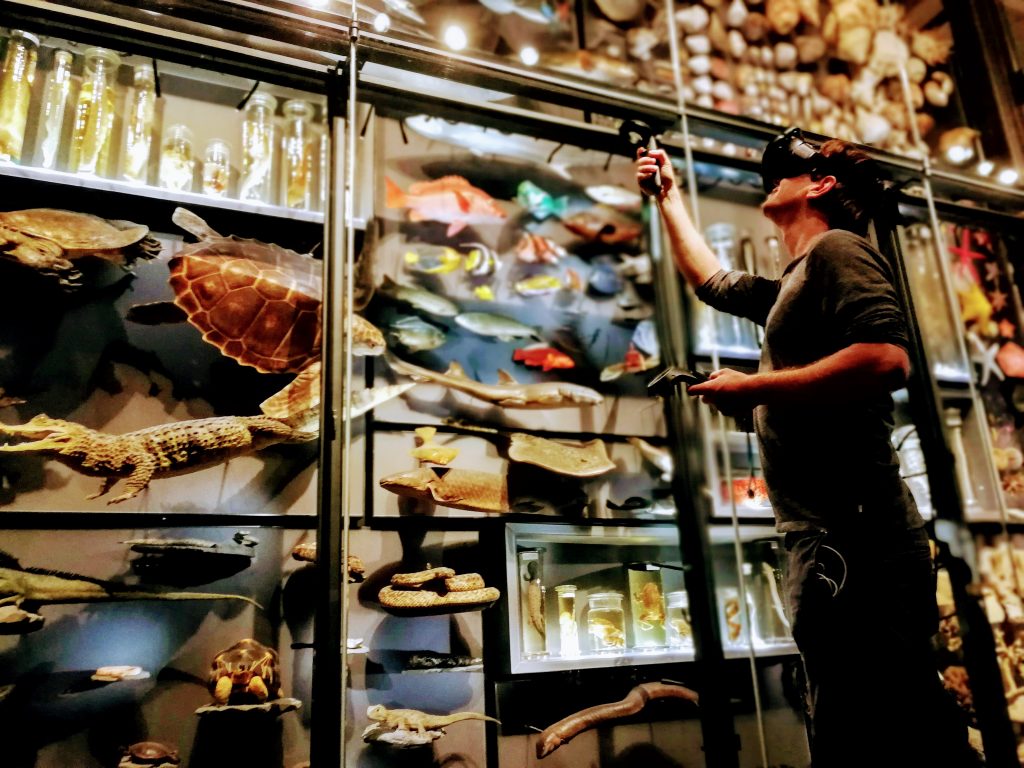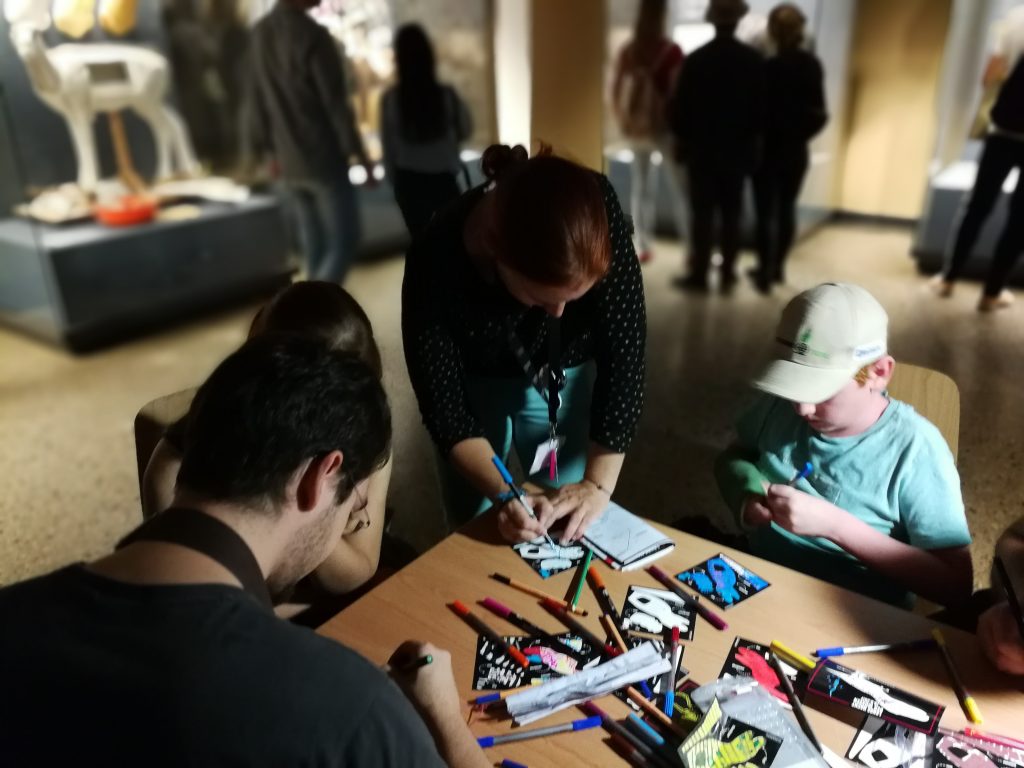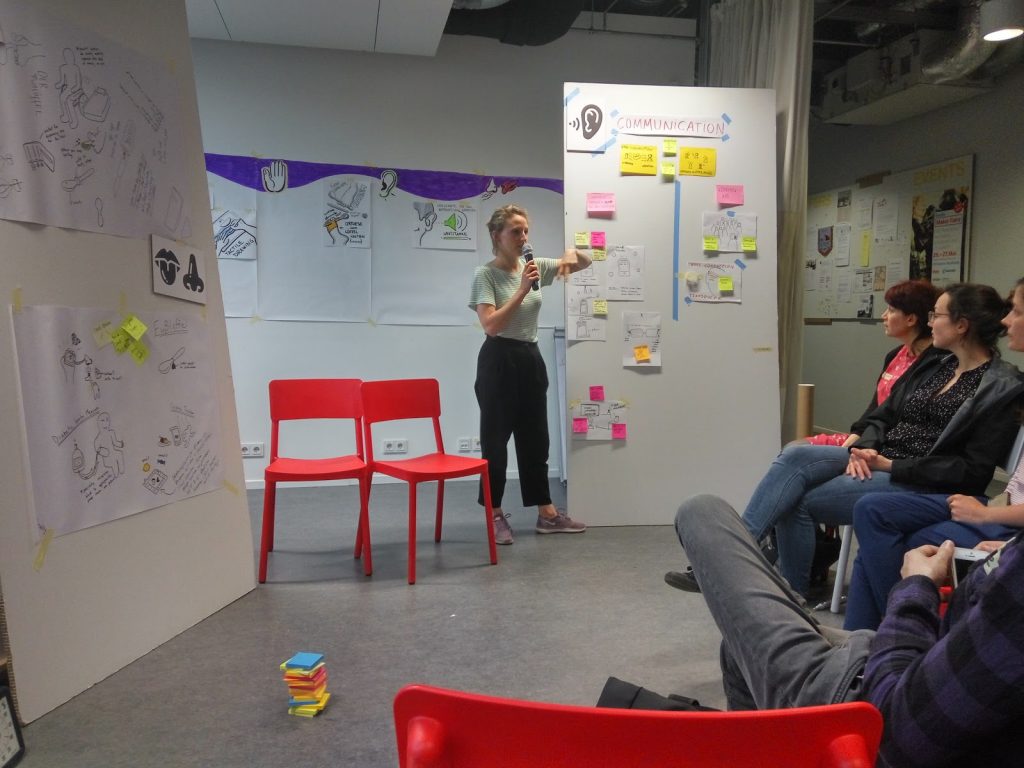
by Robert Richter & Daniel Wessolek
The brand-new Futurium and the well-established Museum für Naturkunde (Natural History Museum) are both situated in the center of Berlin and target a similar audience. The Museum für Naturkunde, a research museum, houses a scientific collection of approximately 30 million physical objects, and a similar amount of digital assets. A current goal is to make this data treasure accessible to the public in a structured way. The objective of the Futurium Lab, situated within the newly built Futurium, is to create tangible objects and to prototype imaginative artifacts for desirable futures, while empowering visitors through skill learning and knowledge about processes in participatory sessions. Within the Museum für Naturkunde, computer numerical controlled (CNC) machinery is seen as a way to make these digital artifacts approachable not only in a virtual way.
Fig 1. Virtual Reality installation at the wall of biodiversity in the Museum für Naturkunde Berlin.
While one of the two institutions focuses on the history of life on this planet, the other is committed to the exploration of future living and production. Or in other words: While one museum describes how we got here, the other explores how we can stay. Of course these two approaches are necessarily intertwined. However, establishing machine shops or fabrication laboratories within larger institutions, specifically in museums, is a major challenge, as planning and processes are embedded in frameworks not necessarily designed for fluid and ad-hoc tinkering. Ideally one would be able to predict and plan machine and material needs well in advance, but as one can imagine, the process of finding the right combination of tools and materials for a specific use-case is an iterative process requiring constant trial and error. Adapting processes common in the maker culture to the special requirements inherent in these large institutions requires learning from both sides.
Fig 2. Visitors colouring a 2D map of a T.Rex that later gets converted in a 3D model (Museum für Naturkunde Berlin).
Though expensive, it is relatively easy to superficially recreate all key features of a makerspace by buying equipment. However, the value of a functioning “Fablab” clearly lies in the community that it harbours. It is essential for a functioning laboratory, that research and development are an integral part of the daily practice in order to inspire visitors and foster the interest in skill learning and application thereof. A culture of free-minded innovation can only be nurtured when accessibility, collaboration and decision making channels are as barrier free as possible. This also includes accessibility to the space and the machines with respect to opening hours, and a pragmatic (legal) framework for usage. Any larger institution planning to establish a shared workshop is therefore advised to critically question whether its rules and existing structures allow for the mentioned community building or if it is willing to change if necessary.
Fig 3. Maker Communities: Brainstorming meet-up with users/makers on sensory augmentation
Despite these challenges, the openness of current institutions to accommodate a culture of making and open innovation is helpful for reaching out to new and potentially larger audiences and promoting maker culture in general. There is also special potential of institutional-backed labs which do not depend on charging for machining minutes in the same way as a commercial entity would need to. Through combining machining infrastructure and knowledge sharing about making with the underlying goals of informing about the past in new ways and empowering people for futures to come are in itself signs that maker culture positively influences society in its core and that decision makers are clearly aware of the underlying potentials.
Fig 4. A Macaw on a plate (replacing the meat in a traditional German meal) representing the link between endangered Macaw populations and industrial meat production.
Disclaimer: The opinions expressed in this article are those of the authors, and they do not reflect in any way those of the institutions to which they are affiliated.
about the authors
Robert Richter studied physics at the Technische Universität Berlin (TUB) from 2003 to 2009. Since 2006 he taught various laboratory courses and in 2013 became the head of the Projektlabor Physik, an innovative project based undergraduate physics laboratory course. He held this position till 2015 when he completed his PhD on the photoluminescence of Nanodiamonds.
In 2016 he was asked to establish and lead the Media Sphere Lab at the Museum für Naturkunde Berlin (Natural History Museum Berlin). As chief scientist he overvied the collaboration between the museum and startups.
He currently teaches science communication courses at TUB and his research is focused on maker culture, DIY Science and science communication.
Daniel Wessolek is interested in assistive design and aims to combine personal fabrication and co-design processes to solve everyday marginalized problems. Previously he has been a postdoctoral research fellow at Singapore University for Technology and Design (SUTD). In 2016 he defended his PhD in Art and Design on “Simple Displays” at Bauhaus University Weimar, where he also worked as a research associate in Interaction Design. He also holds an MFA in Media Art & Design from Bauhaus University Weimar, an MA in Art Theory from Tongji University Shanghai and a BA in Digital Media from University of the Arts Bremen.




